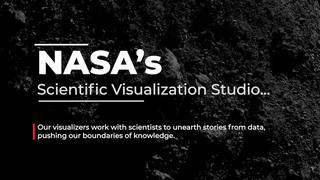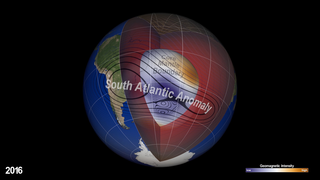Earth
ID: 4840
The bulk of Earth’s magnetic field originates deep within its core, at the boundary between the molten outer core and the solid mantle. The magnetic field extends past the surface into space and acts like a protective shield around the planet, repelling and trapping charged particles from the Sun. But over South America and the southern Atlantic ocean, an unusually weak spot in the field, called the South Atlantic Anomaly (SAA), allows these particles to dip much closer to the surface. Particle radiation in the SAA can knock out onboard computers and interfere with the data collection of satellites that pass through it.
The SAA creates no visible impacts on daily life on the surface, and its weakening magnetic intensity is still within the bounds of what scientists consider normal variation. However, recent observations and forecasts show that the region is expanding westward and continuing to weaken in intensity. Observational data from 2015-2020 found that the SAA has recently started to split from a single valley, or region of minimum field strength, into two cells; and models out to the year 2025 show the split continuing in the future, creating additional challenges for satellite missions.
NASA’s geomagnetic and geophysical research groups are using observations and models to monitor and predict future changes in the SAA and the rest of Earth’s geomagnetic field – helping prepare for future challenges to satellites and humans in space.




South Atlantic Anomaly: 2015 through 2025
The SAA creates no visible impacts on daily life on the surface, and its weakening magnetic intensity is still within the bounds of what scientists consider normal variation. However, recent observations and forecasts show that the region is expanding westward and continuing to weaken in intensity. Observational data from 2015-2020 found that the SAA has recently started to split from a single valley, or region of minimum field strength, into two cells; and models out to the year 2025 show the split continuing in the future, creating additional challenges for satellite missions.
NASA’s geomagnetic and geophysical research groups are using observations and models to monitor and predict future changes in the SAA and the rest of Earth’s geomagnetic field – helping prepare for future challenges to satellites and humans in space.




Used Elsewhere In
Visualization Credits
Greg Shirah (NASA/GSFC): Lead Visualizer
Weijia Kuang (NASA/GSFC): Lead Scientist
Ellen T. Gray (ADNET Systems, Inc.): Writer
Jessica Merzdorf (Telophase): Producer
Andrew Tangborn (UMBC): Scientist
Terence J. Sabaka (NASA/GSFC): Scientist
Scott Luthcke (NASA/GSFC): Scientist
Laurence Schuler (ADNET Systems, Inc.): Technical Support
Ian Jones (ADNET Systems, Inc.): Technical Support
Weijia Kuang (NASA/GSFC): Lead Scientist
Ellen T. Gray (ADNET Systems, Inc.): Writer
Jessica Merzdorf (Telophase): Producer
Andrew Tangborn (UMBC): Scientist
Terence J. Sabaka (NASA/GSFC): Scientist
Scott Luthcke (NASA/GSFC): Scientist
Laurence Schuler (ADNET Systems, Inc.): Technical Support
Ian Jones (ADNET Systems, Inc.): Technical Support
Please give credit for this item to:
NASA's Scientific Visualization Studio
NASA's Scientific Visualization Studio
Short URL to share this page:
https://svs.gsfc.nasa.gov/4840
Data Used:
Note: While we identify the data sets used in these visualizations, we do not store any further details nor the data sets themselves on our site.
Keywords:
DLESE >> Geology
DLESE >> Geophysics
SVS >> Magnetic Fields
GCMD >> Earth Science >> Solid Earth >> Geomagnetism >> Magnetic Anomalies
SVS >> Hyperwall
NASA Science >> Earth
GCMD keywords can be found on the Internet with the following citation: Olsen, L.M., G. Major, K. Shein, J. Scialdone, S. Ritz, T. Stevens, M. Morahan, A. Aleman, R. Vogel, S. Leicester, H. Weir, M. Meaux, S. Grebas, C.Solomon, M. Holland, T. Northcutt, R. A. Restrepo, R. Bilodeau, 2013. NASA/Global Change Master Directory (GCMD) Earth Science Keywords. Version 8.0.0.0.0
https://svs.gsfc.nasa.gov/4840
Data Used:
GTOPO30 Topography and Bathymetry
Data Compilation - USGSTerra and Aqua/MODIS/Blue Marble: Next Generation also referred to as: BMNG
Credit:
The Blue Marble data is courtesy of Reto Stockli (NASA/GSFC).
The Blue Marble data is courtesy of Reto Stockli (NASA/GSFC).
CM6 geomagnetic field model and GEMS assimilation system
Model - NASA/GSFC - 2015-2025
2015-2019: global geomagnetic field made by CM6 from satellite and observatory magnetic data; 2020-2025: geomagnetic forecasts made by GEMS (Geomagnetic Ensemble Modeling System)
Keywords:
DLESE >> Geology
DLESE >> Geophysics
SVS >> Magnetic Fields
GCMD >> Earth Science >> Solid Earth >> Geomagnetism >> Magnetic Anomalies
SVS >> Hyperwall
NASA Science >> Earth
GCMD keywords can be found on the Internet with the following citation: Olsen, L.M., G. Major, K. Shein, J. Scialdone, S. Ritz, T. Stevens, M. Morahan, A. Aleman, R. Vogel, S. Leicester, H. Weir, M. Meaux, S. Grebas, C.Solomon, M. Holland, T. Northcutt, R. A. Restrepo, R. Bilodeau, 2013. NASA/Global Change Master Directory (GCMD) Earth Science Keywords. Version 8.0.0.0.0













